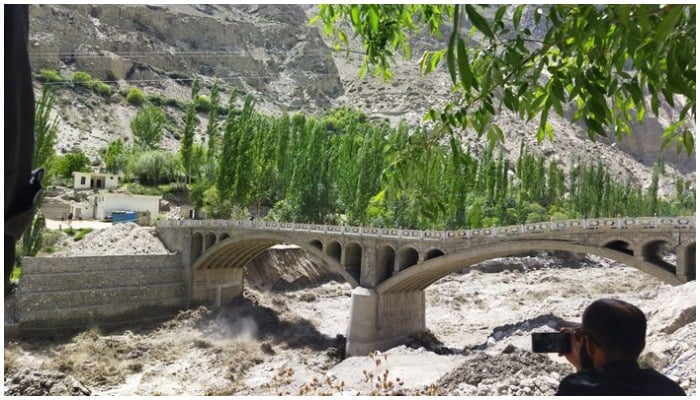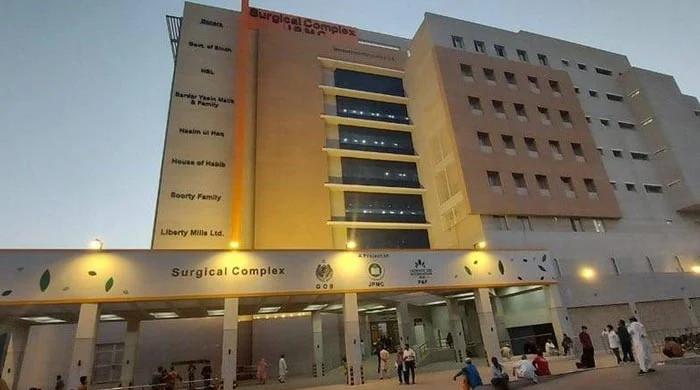Glacial lake flooding leaves Hunza, Gilgit disconnected
PM's Adviser on Gilgit-Baltistan Qamar Zaman Kaira issues directives for all necessary steps to deal with situation.
May 08, 2022

- Official says flow of water reduced by Sunday morning, drinking and agricultural water system destroyed.
- Kaira issues directives for all necessary steps to deal with situation.
- Expert says lake outburst was triggered because of abrupt temperature rise in Northern Areas.
ISLAMABAD: A massive glacial lake outburst flood (GLOF) occurred in Hunza district's Hassanabad village Saturday, sweeping away the Hassanabad bridge on the Karakoram Highway. The Shisper Glacier started discharging 5,000 cusecs of water owing to premature melting, leaving Hunza, Gilgit disconnected.
The flow of water, however, reduced by Sunday morning, Hunza Deputy Commissioner Usman Ali said.
The official said that a temporary bridge will be built after the water completely drains out of the lake.
Speaking about the damages caused by the flooding, Ali said that a jamaat khana was partially damaged while the drinking and agricultural water system has been destroyed.
He further stated that 22 houses have been vacated and small vehicles are transported through Sharae Nagar.
Meanwhile, Adviser to Prime Minister on Kashmir Affairs and Gilgit-Baltistan Qamar Zaman Kaira spoke to the Gilgit-Baltistan chief secretary over telephone. The GB chief secretary briefed Kaira on the Hassanabad bridge collapse in Hunza.
Kaira issued directives to make all neccessary arrangements. He said that steps should be taken on priority basis to restore land connectivity and routine life in the surrounding areas.
Scottish meteorologist warns of more glacier meetings
Scottish Meteorologist Scott Duncan warned that there could be more glacial meltings due to continuously rising temperatures. He forecast that the temperatures would "inevitably surpass the 50°C mark" soon with intensifying heat in the sub-continent.
"Extreme and prolonged heat in Pakistan has helped trigger a Glacial Lake Outburst Flood with catastrophic consequences. Sadly, there could be more to come. Temperatures will inevitably surpass the 50°C mark in the coming days as the heat intensifies in Southern Asia," Duncan wrote on Twitter.
What caused the flooding?
Remote Sensing Specialist at the International Centre for Integrated Mountain Development Dr Sher Mohammad, speaking about the causes of the flooding, said that the glacial lake size was 15% more than the recorded size for the last three years at the pre-outburst level of the lake.
He said the massive Glacial Lake Outburst Flood (GLOF) in Hunza from Shishper Glacier was mainly triggered because of an abrupt temperature rise in the Northern Areas due to the prevailing heatwave phenomenon. He said that the glaciers were melting at a faster pace mainly due to heatwave, adding that in the last 20 days, there has been a 40% increase in the Shisper Glacier lake area due to expedited melting after heatwave impacts gripped the Northern Areas. Mostly, glacial lakes are formed in May but it got developed one month ahead in April.
Dr Sher said the Karakoram Highway Bridge was partially damaged due to the massive flooding that disconnected Gilgit and Hunza. It was the only major collateral damage reported due to GLOF, he said and added not only are glacial lakes rapidly forming in them, they are also appearing ahead of their normal time and bursting into floods.
Dr Sher Mohammad in his research has revealed that lakes on at least five glaciers appeared prematurely in the month of April and some of them have erupted where the water was running faster than usual. "We have been able to record only five glacial lakes due to continuous clouds, which are increasing but the number could be much higher."
He underscored that there were supra-glacial lakes formed over vulnerable glaciers after rapid increase in temperatures and could become a lurking threat in the coming days as more increase in temperature would drive glacial flooding further.
He said satellite reports and images of the five glacier lakes could indicate that other glaciers in the area could also pose a threat to the lakes. "This is not usually the case in April and glaciers and lakes are recorded in the month of June or later, but temperatures above five degrees Celsius can cause a number of natural disasters," he warned.
Gilgit-Baltistan and Khyber Pakhtunhwa disaster management authorities were informed in time to take preventive measures to cope with imminent threat of GLOF in the region. The Hunza district administration officials, taking disaster preparedness measures, relocated the residents from vulnerable sites to safer places and were not facing any threat due to GLOF. The Gilgit-Baltistan district administration officials said that the glacial lake achieved flooding status at 7am on Saturday morning.
Earlier, Gilgit-Baltistan Disaster Management Authority (GBDMA) officials said that keeping in view the prevailing situation and expected GLOF risk, the GBDMA teams were well prepared and trained to carry out community sensitisation, local population’s relocation and food stockpiling 10 days ahead of the Met Office’s threat alert of GLOF.
Dr Sher Mohammad said that the Shisper Glacier had started surging in 2018 and breached thrice from 2019 to 2020. He said continuous monitoring was a key to developing well-informed preparedness plans and contingency measures to avoid massive life and property loss during the insurmountable natural hazard.
FM Bilawal concerned over rapid melting of glaciers
Meanwhile, Minister for Foreign Affairs Bilawal Bhutto Zardari said that rapid melting of glaciers in Gilgit-Baltistan is a matter of concern.
In his statement on the flood situation in Gilgit, he said that the situation created by the eruption of the lake on the Shisper Glacier needs to be dealt with on an urgent basis to ensure that no harm is done to the local population and the land routes remain open.
Bilawal went on to say that he hopes the administration will ensure that ordinary people and tourists do not face any difficulties.
The foreign minister further said that the people of Gilgit-Baltistan will not be left alone by the PPP in difficult times.
The PPP chairman added that the rapid melting of glaciers is a matter of concern adding that collective and concerted efforts on the issue of climate change are a necessity.













